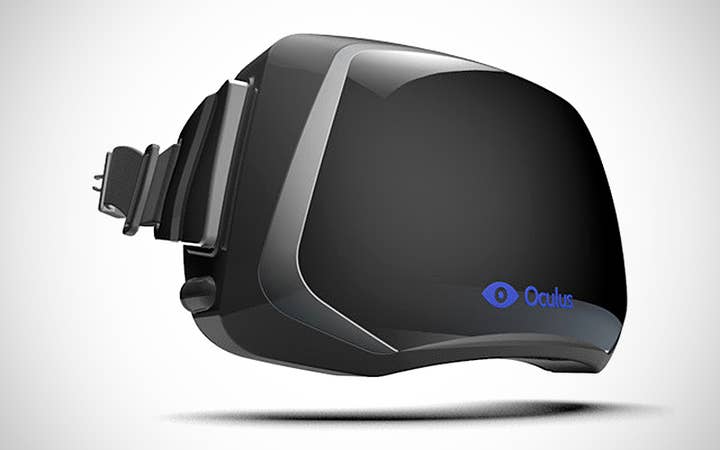Oculus Rift and the Virtual Reality Revolution
Oculus founder Palmer Luckey on the next big platform for gaming
There has been no shortage of articles about the Oculus Rift since its startling debut under the auspices of John Carmack at E3 this year. And thin-skinned journalists will be less than delighted to know that, in the eyes of one individual, very few of those articles have passed muster. Who is this person watching from the shadows, quietly judging our coverage of the industry's latest stab at virtual reality? Well, its inventor, Palmer Luckey.
You see, prior to becoming one of the most talked about Kickstarter success stories, Luckey was a journalism major. He had tired of reading articles on his favourite tech sites that seemed to be written by “iPhone-toting hipsters” who had an obvious paucity of relevant knowledge. They wanted gadgets, they owned gadgets, but they didn't really understand what they were or how they worked. The very fact that this article is about Luckey rather than by him tells you all you need to know about his nascent journalism career, but when the flood of Oculus Rift coverage started this summer, the old flaws were present and correct.
"Virtual reality is going to be a platform, and not just something that you plug into the console. We're going to get to the point where the headset is the console"
“Some of them said it was John Carmack's invention,” Luckey says, grimacing. “PC Gamer had the worst article by far: they said that Carmack was working with an industrial design firm in Texas. I'm not Texan, I'm not an industrial designer, I'm not a firm. The worst part was they had a video embedded in the article in which Carmack says my name, that I live in California, and there's a URL for my website on the wall.”
The relative ease of fact-checking notwithstanding, the mistake that the Oculus Rift was a product of John Carmack's bright and questing mind was easy to make. Virtual reality may still seem to be a futuristic concept, but the games industry has been trying - and failing, often spectacularly - to harness its allure for consumers since the mid-Nineties. So when a figure like Carmack uses the world's most public gaming event to proclaim that somebody finally got it right, it's only natural to assume that he had a hand in its creation, and that he had help along the way.
In fact, Carmack's contribution was simply to stumble across some of Luckey's posts on an online forum. id Software's legendary co-founder had a longstanding interest in virtual reality technology, and, with his interest piqued by Luckey's work, he asked to buy a prototype.
“I told him I'd build him one for free instead. Only good things can come from working with John Carmack,” Luckey recalls. “E3 surprised me too, actually. I didn't know that much about him doing it until he actually did it. I was at a display conference in Boston, Display Week, and I didn't find out about it until the last day. One of my friends sent me a text: 'Dude, that's so cool, Carmack's got your headset at E3'. What?”

Carmack's largesse was both a ringing endorsement of the product and a catalyst for Luckey to shift into high gear - “The reaction was good enough,” he says. Until that point, his attempts to create a technically proficient head-mounted display had been motivated by personal considerations. In short, Luckey is a lifelong gamer, virtual reality is a cool concept, and every existing product he had managed to acquire had run the gamut from disappointing to outright embarrassing. By the time he had bought 20 different devices, it became clear that, if he wanted a good virtual reality headset, he wasn't just going to find one on eBay. He would have to take on the responsibility of building it himself.
Fortunately, with so many failed attempts to reference the major obstacles were easy to spot. “Good tracking, low latency tracking, hadn't been done very well,” he says. “Wide field of view - that's the main thing. Most of the headsets that reached the market had a pitiful field of view. [The Oculus Rift] is not just twice as wide, it's also much taller, so it's actually four to six times as large as the field of view of most other headsets. It's hard to quantify, but subjectively it's a huge difference: it's like the difference between playing on a 19-inch monitor and a 50-inch TV.”
For Luckey, display technology has the most potential to push gaming into new territory, and it could have happened a long time before the Oculus Rift breezed past its $250,000 Kickstarter goal in September. The technology in the prototype Luckey is showed at the Evolve developer conference in London last week has been available and affordable for several years. Anybody with the right skills could have built a similar headset, but nobody was trying.
“It's not exactly a case of the right place at the right time, and the right thing got picked up by the right person,” he says, though he concedes that there are elements of each of those things at play. “All of the components in this prototype have existed since late 2008. It's old stuff: four-year old technology. We have fitted it with a more modern display and a better tracker since [the Kickstarter campaign], but what everyone has been writing and raving about since then existed in 2008.”
This is the most remarkable detail in the Oculus Rift story. In less than a year, Luckey has gone from an enterprising hobbyist to a widely discussed industry figure, bringing virtual reality back into the discussion after many years without progress, and eliciting glowing praise from Carmack, Valve's Gabe Newell and Mojang's Markus Persson in the process. But for all the rapidity of the Oculus Rift's rise, it could have been created by any number of companies in the industry, and had a company done so, Luckey would have been one of its first and most eager customers.
The problem, I suggest, is that virtual reality's chequered history has led to both the industry and its consumers regarding it as a gimmick. In winning over John Carmack and people of similar standing, Luckey has been able to convince the cynics that virtual reality was not just the preserve of Star Trek fantasists.
“It's not a gimmick if it works; it's a gimmick if it's novelty for novelty's sake,” he says. “Look at motion-controllers: Have you ever seen the Sega Activator? Okay, that's a motion-control gimmick because it sucks. It's interesting, but it sucks. The power glove sucked less, but it was also pretty much a gimmick. But now that motion-control technology is in the right place, we can see that it's not a gimmick because it can actually lead to gameplay experiences that didn't exist before.
“It's not just a peripheral. Virtual reality is going to be a platform, and not just something that you plug into the console. We're going to get to the point where the headset is the console.”
It's the sort of bold claim that's far easier to make before the first dev kits have even been delivered, but Luckey clearly understands the task ahead. If the Oculus Rift is to be the first major step in getting virtual reality into consumer homes, the thing it simply cannot do without is games - compelling experiences that both use and enhance the technology. Fortunately, the Kickstarter campaign also doubled as rudimentary market research: even if a few of the backers mistakenly believed they were buying a finished product, there still leaves thousands and thousands of interested parties who are almost certainly game developers.

And the enquiries didn't stop with Kickstarter. Luckey and his associates have met with hundreds of developers since the campaign closed, and he tells me there are thousands more that he didn't have time to see. While most nascent platforms from small operations like Oculus would be devoting considerable effort and resources reaching out to developers, Luckey has the luxury of the developers coming to him. This, he explains, will be the difference between Oculus Rift and platforms that falter after their honeymoon period - like, say, Microsoft's Kinect.
“Let's look at Kinect: there are some good first-party titles, but there aren't exactly hordes of third-party developers banging down Microsoft's door pleading for Kinect integration. They maybe don't see huge potential. They aren't that excited by it. But we have so many people - from big developers to indies - saying that they need virtual reality in their games. They want to do it. They want to be inside their games, and they want that for consumers, too. It's a good enough technology that it's not just a bunch of suits at the top.”
"We have so many developers saying that they need virtual reality in their games. It's a good enough technology that it's not just a bunch of suits at the top"
One of the problems that Kinect has arguably failed to overcome is the challenge the technology made to some of the most fundamental aspects of game design - how to navigate and look around a 3D space, for example. The Oculus Rift, on the other hand, is seductively accessible when it comes to gameplay: the technology logically fits the majority of existing game genres, and is a particularly good fit for first-person shooters, racing games and just about anything that puts the player behind the eyes of an avatar. That accounst for a good number of the most popular IPs in gaming.
However, the potential of the Oculus Rift as an immersive addition to a Call of Duty play session is the least we should expect from virtual reality technology. The majority of the excitement around Luckey's device emanated from the independent sector, and there's a good reason for that: the Oculus Rift will make headshots, explosions and hairpin bends more awesome, sure, but that inviting extra layer of immersion could allow developers to move in exactly the opposite direction. Over the course of our conversation we discuss games like Hawken and Star Citizen, but we also linger over slower and more contemplative experiences like thechineseroom's Dear Esther and The Fullbright Company's forthcoming Gone Home. With virtual reality, these games would have an entirely new level of appeal.
“The whole point of Dear Esther is not to accomplish goals and hit checkpoints," Luckey says. "It's just to experience the game, to make you feel like you're there. This could be very powerful for that kind of experience, as opposed to something like Counter Strike, which is based around maximum performance and superhuman reflexes in targeting. That probably isn't the game that will benefit the most from virtual reality. Honestly, a keyboard and mouse are superhuman interfaces; with VR, you're limiting yourself to what your body can actually do.”
And for the foreseeable future the Oculus Rift's home will be on the PC, where independent developers will be able to test its potential and limitations comfortably ahead of any plans the console companies might have. Not least because, for games to perform at 30fps or 60fps, the Oculus Rift will require more powerful consoles. And more powerful consoles will arrive in due course, at which point Luckey hopes that they will provide the next step in his grand plan.
“We'll be successful even if we only sell to indies," he says. "We don't have to sell to the Halos and Call of Dutys, but at some point that's what it's going to take. Maybe not now, maybe not next year, but at some point that's what we'll need to start a virtual reality gaming revolution.”









